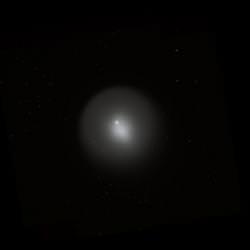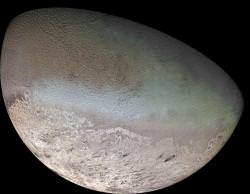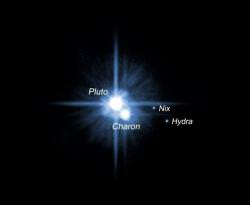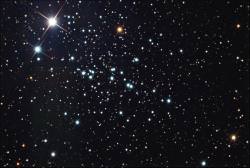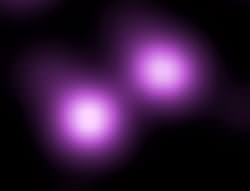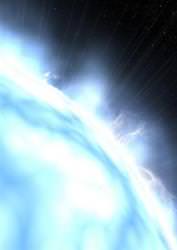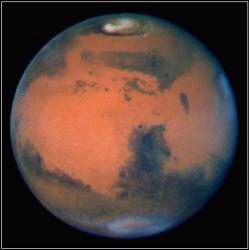Monday, November 26 – Today in 1965 marked the launch of the first French satellite – Asterix 1. Today is also the seventh anniversary of the discovery of the meteorites SAU 005 & 008: the “Mars Meteorites.” These meteorites are known to be of Martian origin because of gases preserved in the glassy material of their interior. They were hurled into space some 600,000 years ago when a probable asteroid impact on Mars tossed them high enough to escape the planet’s gravity, and they were captured by our gravity these many thousands of years later. They are just two of the 32 meteorites found on Earth which have been positively determined from their chemical compositions to be of Martian origin.
Thanks to just a slightly later rise of the Moon, let’s return again to Cassiopeia and start at the central-most bright star, Gamma. Four degrees southeast is our marker for this starhop, Phi Cassiopeiae. By aiming binoculars or telescopes at this star, it is very easy to locate an interesting open cluster, NGC 457, because they will be in the same field of view.
This bright and splendid galactic cluster has received a variety of names over the years because of its uncanny resemblance to a figure. Some call it an “Angel,” others see it as the “Zuni Thunderbird;” I’ve heard it called the “Owl” and the “Dragonfly,” but perhaps my favorite is the “E.T. Cluster,” As you view it, you can see why! Bright Phi and HD 7902 appear like “eyes” in the dark and the dozens of stars that make up the “body” appear like outstretched “arms” or “wings.” (For E.T. fans? Check out the red “heart” in the center.)
All this is very fanciful, but what is NGC 457, really? Both Phi and HD 7902 may not be true members of the cluster. If 5th magnitude Phi were actually part of this grouping, it would have to have a distance of approximately 9300 light-years, making it the most luminous star in the sky, far outshining even Rigel! To get a rough of idea of what that means, if we were to view our own Sun from this far away, it would be no more than magnitude 17.5. The fainter members of NGC 457 comprise a relatively young star cluster that spans about 30 light-years. Most of the stars are only about 10 million years old, yet there is an 8.6 magnitude red supergiant in the center. No matter what you call it, NGC 457 is an entertaining and bright cluster that you will find yourself returning to again and again. Enjoy!
Tuesday, November 27 – Tonight let’s take advantage of early dark and venture further into Cassiopeia. Returning to Gamma, we will move towards the southeast and identify Delta. Also known as Ruchbah, this long-term and very slight variable star is about 45 light-years away, but we are going to use it as our marker as we head just one degree northeast and discover M103.
As the last object in the original Messier catalog, M103 (NGC 581) was actually credited to MÈchain in 1781. Easily spotted in binoculars and small scopes, this rich open cluster is around magnitude 7, making it a prime study object. At about 8000 light-years away and spanning approximately 15 light-years, M103 offers up superb views in a variety of magnitudes and colors, with a notable red in the south and a pleasing yellow and blue double to the northwest.
Viewers with telescopes and larger binoculars are encouraged to move about a degree and half east of M103 to view a small and challenging chain of open clusters, NGCs 654, 663 and 659! Surprisingly larger than M103, NGC 663 is a lovely fan-shaped concentration of stars with about 15 or so members that resolve easily to smaller aperture. For the telescope, head north for NGC 654, (difficult, but not impossible to even a 114mm scope) which has a bright star on its southern border. South of NGC 663 is NGC 659 which is definitely a challenge for small scopes, but its presence will be revealed just northeast of two conspicuous stars in the field of view.
If you are out when the Moon rises tonight, enjoy seeing Mars very nearby – less than 2 degrees away! And speaking of degrees, today is also the birthday of Anders Celsius – born in 1701.
Wednesday, November 28 – Once again utilizing early darkness, let’s go back to Cassiopeia. Remembering Alpha’s position as the westernmost star, go there with your finderscope or binoculars and locate bright Sigma and Rho (each has a dimmer companion). They will appear to the southwest of Alpha. It is between these two stars that you will find NGC 7789 (RA 23 57 24.00 Dec +56 42 30.0).
Absolutely one of the finest of rich galactic opens bordering on a loose globular, NGC 7789 has a population of about 1000 stars and spans a mind-boggling 40 light-years. At well over a billion years old, the stars in this 5000 light-year distant galactic cluster have already evolved into red-giants or super-giants. Discovered by Caroline Herschel in the 18th century, this huge cloud of stars has an average magnitude of 10, making it a great large binocular object, a superb small telescope target, and a total fantasy of resolution for larger instruments.
Tonight in 1659, Christian Huygens was busy at the eyepiece – but he wasn’t studying Saturn. This was the first time any astronomer had seen dark markings on Mars!
Thursday, November 29 – Today in 1961, Mercury 5 launched Enos the Chimp into fame!
With a short time until the Moon rises tonight, why not journey with me once again to Cassiopeia? We will start our studies with the western-most of the bright stars – Beta. Also known as “Caph,” Beta Cassiopeiae is approximately 45 light-years away and is known to be a rapid variable. Viewers with larger telescopes are challenged to find the 14th magnitude optical companion to Caph at about 23″ in separation. Tonight, using our previous study stars Alpha and Beta, we are going to learn to locate a Messier object with ease! By drawing an imaginary line between Alpha and Beta, we extend that line the same distance and angle beyond Beta and find M52.
Found on September 7, 1774 by Charles Messier, this magnitude 7 galactic cluster is easily seen in both binoculars and small telescopes. Comprised of roughly 200 members, this open cluster is roughly 3,000 light-years distant and spans approximately 10-15 light-years. Containing stars of several different magnitudes, larger telescopes will easily perceive blue components as well as orange and yellow. Also known as NGC 7654, M52 is a young, very compressed cluster whose approximate age is about the same as the Pleiades.
For those with large telescopes wanting a challenge? Try spotting a faint patch of nebulosity just 36′ to the southwest. This is NGC 7635, more commonly known as the “Bubble Nebula.” Best of luck!
Friday, November 30 – If you are up before dawn, Look for bright Venus and cool, blue Spica less than a fistwidth apart – and look for the Moon and Regulus! Less than half a degree of separation means a possible occultation event, so be sure to check IOTA information. Just as a curiosity, on this day in 1954, Elizabeth Hodges was struck by a five kilogram meteorite in Alabama. Duck!
Tonight we will haunt Cassiopeia one last time – with studies for the seasoned observer. Our first challenge of the evening will be to return to Gamma where we will locate two patches of nebulosity in the same field of view. IC 59 and IC 63 are challenging because of the bright influence of the star, but by moving the star to the edge of the field of view you may be able to locate these two splendid small nebulae. If you do not have success with this pair, why not move on to Alpha? About one and a half degrees due east, you will find a small collection of finderscope stars that mark the area of NGC 281 (RA 00 52 25.10 Dec +56 33 54.0). This distinctive cloud of stars and ghostly nebulae make this NGC object a fine challenge!
The last things we will study are two small elliptical galaxies that are achievable in mid-sized scopes. Locate Omicron Cassiopeiae about 7 degrees north of M31 and discover a close galactic pair that is associated with the Andromeda group – NGC 185 (RA 00 38 57.40 Dec +48 20 14.4) and NGC 147 (RA 00 33 11.79 Dec +48 30 24.8).
The constellation of Cassiopeia contains many, many more fine star clusters, and nebulae – and even more galaxies. For the casual observer, simply tracing over the rich star fields with binoculars is a true pleasure, for there are many bright asterisms best enjoyed at low power. Scopists will return to “rock with the Queen” year after year for its many challenging treasures. Enjoy it tonight!
Saturday, December 1 – Born today in 1811 was Benjamin (Don Benito) Wilson. He was the namesake of Mt. Wilson, California – home to what once were the largest telescopes in the world – the 60″ Hale and the 100″ Hooker. Later, three solar telescopes were added on the mountain – two of which are still in use – as well as the CHARA array and active interferometers. It was here that Edwin Hubble first realized the “nebulae” were distant galaxies and discovered Cepheid variables in them. As we approach the end of our SkyWatching year together, let us pretend the skies are still as dark as they were on Mt. Wilson as we aim our binoculars and telescopes towards one of the most elusive galaxies of all – M33.
Located about one-third the distance between Alpha Triangulum and Beta Andromedae (RA 01 33.9 Dec +30 39), this member of our Local Group was probably first seen by Hodierna, but was recovered independently by Messier some 110 years later. Right on the edge of visibility unaided, M33 spans about 4 full moon widths of sky, making it a beautiful binocular object and a prime view in a low power telescope.
Smaller than the Milky Way and the Andromeda Galaxy, the Triangulum galaxy is about average in size, but anything but average to study. So impressed was Herschel that he gave it its own designation of H V.17 after having cataloged one of its bright star forming regions as H III.150! In 1926, Hubble also studied M33 at Mt. Wilson with the Hooker telescope during his work with Cepheid variables. Larger telescopes often “can’t see” M33 with good reason – it overfills the field of view – but what a view! Not only did Herschel discover a region much like our own Orion Nebula, but the entire galaxy contains many NGC and IC objects (even globular clusters) that can be seen with a larger scope.
Although M33 might be 3 million light-years away, tonight it’s as close as your own dark sky site…
Sunday, December 2 – If you are awake before dawn, enjoy the beauty of Saturn and the Moon as they dance along the ecliptic plane together. For most viewers, the tranquil pair will only be about a fingerwidth apart. Today in 1934, the largest mirror in telescope history began its life as the blank for the 200″ telescope was cast in Corning, NY.
The 200″ would play another important role as Edwin Hubble continued on at Palomar Observatory. Thanks to his work there, we now understand “Hubble’s Law” – the expansion of the Universe. Tonight let us honor that great mind as we take a look at a galaxy that’s receding from us – NGC 1300.
Located about a thumb’s width north of Tau4 Eridani (RA 03 19.7 Dec -19 25), this is probably the most incredible barred spiral you will ever encounter. At magnitude 10, it will require at least a 4.5″ telescope in northern latitudes, but can probably be spotted with binoculars in the far south.
At 75 million light-years away, NGC 1300’s central bar alone is larger than the Milky Way, and this galaxy has been intensively studied because the manner of its formation was so similar that of to our own. Although it is so distant, it is seen face-on – allowing us a look at how this formation occurs without looking through the gas and dust which block our own central view. Enjoy this one’s fantastic structure!

